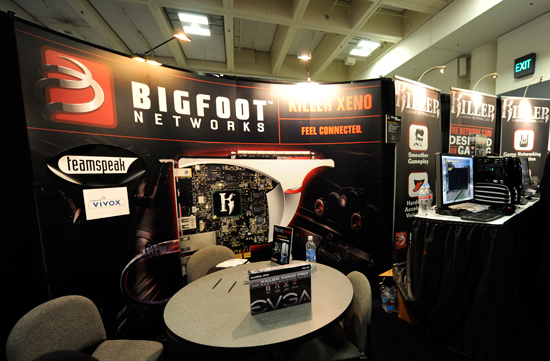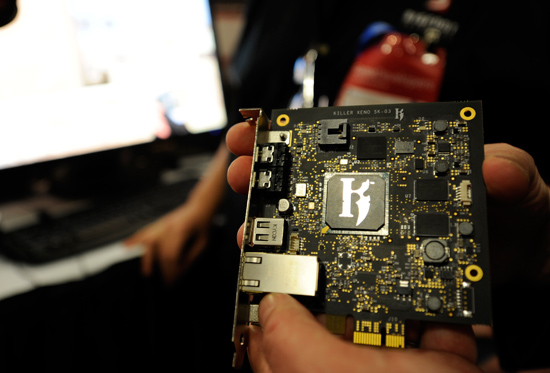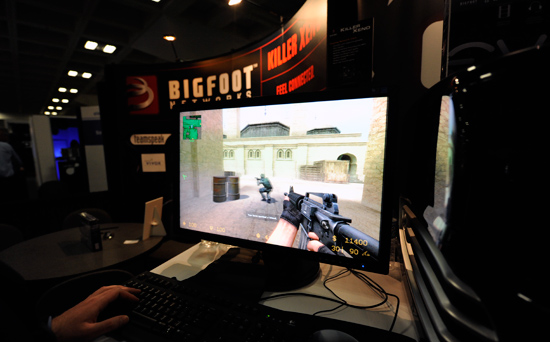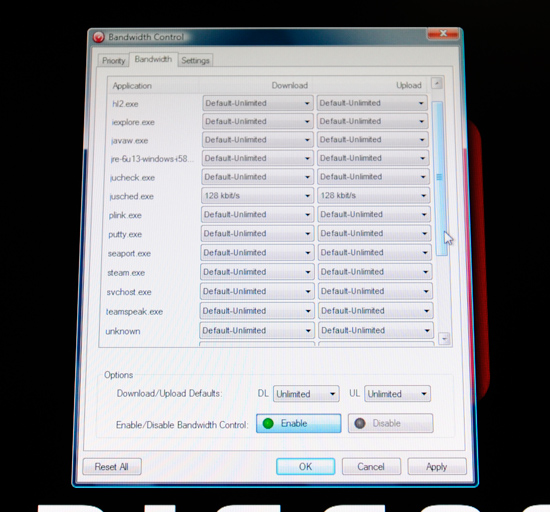Nintendo's Development Secrets, Cloud Gaming & new Killer NIC - GDC '09
by Anand Lal Shimpi & Derek Wilson on March 26, 2009 12:00 AM EST- Posted in
- Trade Shows
Bigfoot is Back: Killer Xeno NIC
You all remember Bigfoot Networks, right? The makers of the Killer NIC? They’re back with a cheaper, updated product: the Killer Xeno.

The Killer Xeno is a network card with an on-board processor, memory and lightweight Linux OS. It serves as a packet accelerator and voice/UDP offload processor for your PC. The idea is that the Windows audio and networking stacks are horribly inefficient and optimized for file transfers, not low latency gaming. The Killer Xeno bypasses the Windows audio/networking stacks and uses its own lightweight stacks to handle all voice chat/networking requests, theoretically translating into lower pings while gaming with voice chat enabled.

The new Killer NIC adds support for voice chat, a feature the original didn't have
We’ll be looking at the Killer Xeno in the not too distant future. Despite there being demos at the booth, none of them were the necessary Killer Xeno vs. No Killer Xeno tests to determine the usefulness of such a thing. We’ll put the card through its paces soon enough.

Counterstrike was the test of choice. Unfortunately there was no reference point for the demo.

The Killer Xeno software includes an application that will let you throttle bandwidth to running processes/applications. The utility can also serve as an automatic alert/defender against undesired outbound or incoming network connections.
The Xeno will ship next month starting at $130.










38 Comments
View All Comments
blagishnessosity - Thursday, March 26, 2009 - link
The way I see it, broadband speeds are decreasing. A decade ago when my family first got road runner, few other families in the neighborhood had it, so there was not nearly the amount of network usage that we see today. Now, everyone has broadband and usage is high, slowing down the network. Now the ISP's are charging more for inferior speeds. In my experience, bandwidth tests back then yielded much higher speeds then they do now. And not just that, I pay more money for less speed (I've always used road runner). So, maybe the technology exists for higher speeds now, but you have to pay a high premium for them. There doesn't appear to be enough competition in the ISP market for this trend to change anytime soon.XiroMisho - Thursday, March 26, 2009 - link
I originally thought this was bloatware... until I tried to do voice chat on a system with a sub par sound card. For the price, and the fact it has voice chat support... then okay, vs buying a better sound card on PCI-E (Which... doesn't exist for under a $150, thank you lethargic sound card community...), this may be worth it... of course going to wait till the price drops to about $79.99.Calin - Thursday, March 26, 2009 - link
This won't help if you're having a sub par sound card. It's like buying larger tires for better grip when you're using a Yugo to tow a large trailer, or somethingBigfootSean - Tuesday, March 31, 2009 - link
Well, sorta. Currently, lots of game voice apps rely on the CPU to do all the encode / decode operations required for gaming voice chat. Sound cards do a good job at DirectSound / EAX sort of stuff, but when it comes to more random stuff like voice, both the apps and the cards develop out of sync.It makes sense for us to do this (and sign up as many partners as possible) because voice chat is a network app that should run on the NIC. Let the CPU worry about the game, let the audio card worry about the explosions and effects, and let the network processor slice, dice, decode, encode and send.
Combined with hardware bandwidth control, this means that your game will never step on your voice chat, and vice versa, assigning clear priorities to each so that neither becomes scrambled.
Thanks for the opportunity to reply!
Lifted - Thursday, March 26, 2009 - link
I still have to play with my friends wii's. :(NewBro - Thursday, March 26, 2009 - link
I'm sorry but am I the only one who thinks the whole OnLive gaming on internet is a terrible idea to start with? First of all the latency issue, and the whole thing running through the internet just doesn't sounds all that great to me. I mean would you want to be interrupted in the middle of a Boss fight in Resident Evil 4 due to a bad connection?xahydra - Sunday, March 29, 2009 - link
Yeah, this whole cloud stuff is getting a little wacky now... Sure there are some really useful services, but it bothers me to see some people get so excited about handing their hardware over little by little and depending on someone else to run their software. I don't want a future filled with dumb terminals that can be managed and controlled more than ever by someone else. The P in PC is for Personal. Its bad enough I have to ask for Microsofts permission to activate my OS when I swap out a peice of hardware. I don't want "subscription software" and "on-demand" gaming... I can pull out my old copy of Freespace 2 and play it at will because it's MINE, I don't have to navigate to the "classics channel" and pay to play over a streamnubie - Friday, March 27, 2009 - link
Personally the ramifications of this are easy to see if you imagine that you could have a server that streams the game to any display you want in or around your house.Instead of having a monster gaming machine tethered to a desk making heat and noise you could have wireless handheld consoles, from the iPhone to the PSP/DS, or even something much slimmer with a 10" screen on a magnesium or aluminum chassis and hours upon hours of battery life. Not to mention streaming to displays all over your house, from the projection room to the kitchen.
What about inviting people over for a "LANparty" without the LAN. Imagine the latency reduction of having everyone on the same system. I can, I already use nVidia dual-view to load up games with split-screen and split-controls onto my PC, and it is a blast (not that these games are common, only a handful of titles at best.)
SLi and Crossfire don't seem particularly interested in allowing users to span 2-8 displays of multi-player goodness from one machine, even though the results are stunning.
The0ne - Thursday, March 26, 2009 - link
I don't think it will work at all when there are tons of users. Sure a few demos and players here seems fine now but just wait til you're at WOW numbers :)Samus - Thursday, March 26, 2009 - link
It makes sense for games like World of Warcraft where latency isn't a big deal...although WoW isn't very graphically intensive to begin with so the service is for the most part unneccessary.FPS's = I agree with you. Latency is ALREADY a problem in deathmatch, and that's measured in milliseconds. I'm sure the video latency will be at least a second.